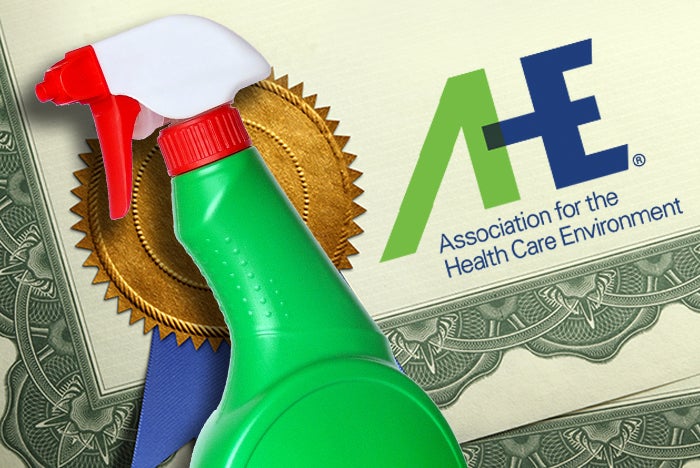Certifications provide stepping stone for health facilities professionals

Credit: Image from Shutterstock
Certifications such as the Certified Healthcare Facility Manager (CHFM) or Certified Healthcare Constructor (CHC) are often seen as a source of professional pride — a few letters after your name showing you have years of experience and a breadth of knowledge in the field.
But a new certification from the American Society for Health Care Engineering (ASHE) takes a bit of a different approach.
The Certified Health Care Physical Environment Worker program doesn’t require years of experience or in-depth expertise. Instead, it simply shows that those who pass the online certification exam understand how to work in the complex health care environment. The worker certification is especially valuable for hospitals seeking to reduce risks associated with construction.
Hospitals can require the certification for workers to make sure they understand key concepts related to keeping patients safe, including infection prevention and fire safety. Workers are ready to work in a hospital from the time they arrive on-site, reducing orientation requirements.
Although this certification is different from CHFM or CHC, all certifications have one thing in common. They can help health care organizations ensure that their leaders and employees are prepared for their jobs. The expertise certified professionals bring to the job each day — regardless of what that job is — directly contributes to safe environments for patients, staff and visitors.
A closer look
The CHFM, CHC and Certified Health Care Physical Environment Worker certifications are available for those involved with building and maintaining the health care physical environment. Other certifications center on health facility design, cleaning and disinfection, and even security operations, among others.
A closer look tells health facility professionals how they and their organizations can benefit from such certifications as well as their requirements:
CHFM designation: For hospitals and health systems, the CHFM is a way to quickly identify qualified individuals. Managing hospitals and health care facilities is a far more complex job than managing other types of buildings. When hiring people to manage these facilities, hospitals often require the CHFM as a prerequisite. Some health care organizations strongly encourage all facility professionals to earn the certification.
By hiring those with the CHFM, hospitals ensure that their facility managers understand five key areas related to the job: maintenance and operations; code compliance; planning, design and construction; financial management; and administration. The CHFM is also a symbol of commitment for facility managers, so organizations that hire CHFMs know they are getting someone who has taken the time and effort to earn the certification.
For individuals, the CHFM can be a career stepping stone. For engineers, technicians and others who may aspire to become a facility manager, earning the CHFM shows that they have the breadth of knowledge it takes to be a facility manager. Even preparing for the certification can help an individual become more efficient in operating a health care facility, potentially aiding career growth.
The CHFM also can boost paychecks. The 2017 Health Facilities Management (HFM) salary survey showed that on average, those with a CHFM certification earned $25,000 a year more than those without the certification.
The program is run by the American Hospital Association’s Certification Center. To qualify for the CHFM exam, an applicant must meet education and experience requirements. For example, those with a bachelor’s degree from an accredited college must have at least three years of experience in a health care engineering position with management responsibilities.
Once qualified, applicants take the CHFM exam, which consists of 110 multiple-choice questions over a two-hour period. The questions include some simple recall questions, but also more complex application and analysis questions. Those who pass the exam become CHFMs. To maintain the credential, CHFMs must earn continuing education units and submit a timely renewal application.
CHC designation: Like the CHFM, the CHC certification is useful to both health care organizations and to the people who receive the certifications.
Hospitals and health systems need to ensure that the construction leaders who work on their projects understand the complexities of health care. Requiring project leaders to hold the CHC certification is a way to do that because to earn a CHC, a constructor must understand the fundamentals of health care; planning, design and construction in health care; health facility safety; and financial stewardship.
For recipients, the CHC is a way to stand out in the market. A construction manager or construction superintendent with certification often has a competitive edge over other noncertified candidates. Bidding awards incorporate the qualifications of the construction team, and the certification makes the selection process easier.
The CHC shows a commitment to health care construction, a market that is more resilient than some other types of construction, which can lead to future opportunities.
Like the CHFM, the CHC program is run by the AHA’s Certification Center. To qualify for the CHC exam, an applicant must meet education and experience requirements. For example, those with a bachelor’s degree from an accredited college must have at least five years of experience in health care construction, with at least three years of management experience.
Once qualified, applicants take the CHFM exam, which consists of 115 multiple-choice questions over a two-hour period.
The exam includes some simple recall questions, but also includes more complex application and analysis questions. Those who pass the exam become CHCs. To maintain the credential, CHCs must earn continuing education units and submit a timely renewal application.
Worker certification: The Certified Health Care Physical Environment Worker certification is a different type of credential than the CHFM or CHC. While the CHC and CHFM cover a wide range of key concepts, the worker certification program covers the basics of what construction workers, day laborers, facility technicians and others need to know before working in health care. Topics include construction in health care facilities; infection control and prevention; fire and life safety; and utility system shutdowns.
The worker certification is a way for construction and facility workers to show they can begin working immediately upon arrival at the job site.
“Facility directors are spending significant resources setting up orientation programs to cover these concepts,” says ASHE Executive Director PJ Andrus, MBA, CAE. “ASHE’s new worker certification is a convenient and effective way to make sure the people on your job site understand what it means to work around patients.”
Unlike the CHFM and CHC exams, the worker certification does not have education or experience requirements. The one-hour exam contains 75 multiple-choice questions, and is offered online so it can be taken at any time. The questions are simple recall questions and do not require experience in health care facilities to answer.
The certification, run by ASHE, is valid for three years. No continuing education credits are required to renew the certification; applicants simply take the online exam again after the initial three-year certification period expires.
Other certifications: There is a wide range of other certifications useful to those involved with designing, building and operating health care facilities. For example, a health care interior designer may choose to become certified as a professional interior designer by IIDA, the Commercial Interior Design Association.
A facility professional responsible for fire safety may want to become a Certified Fire Protection Specialist through the National Fire Protection Association. See the sidebars accompanying this article for information on other certifications related to health care facilities.
Preparing for exams
Several resources are available for those taking the CHFM or CHC exams, including publications, online education programs and practice exams. A starting point is to download the candidate handbook that provides an outline of the exam domains and explains details about the certification.
Health facility professionals should consider their strengths and weaknesses in each domain, and create a study plan to fill in gaps in their knowledge or expertise. Lists of resources can be accessed online for the CHFM and the CHC programs.
Another tip is to find a mentor or colleague who can help provide experience in weaker areas. For example, if a facility engineer has no prior experience with finance and budgeting, he or she may ask his or her manager to get involved in the next budgeting process.
“It’s very common that candidates don’t get much experience in one or more of the domains for certifications,” says ASHE Deputy Executive Director Chad Beebe, AIA, FASHE. “Let others know you are considering the exam and ask for exposure to these domains.”
Resources are also available to prepare for the worker certification, including:
- Working in Health Care Handbook: A Guide for Facility Business Partners, Construction Professionals, and Subcontractors.
- Working in Health Care e-Learning Course
- Today You Are Healthcare video
Additionally, maintaining the CHFM and CHC credentials requires continuing education. ASHE conferences and education programs are a great way to rack up many continuing education credits. If traveling to conferences is difficult, online and free opportunities are also available. For example, ASHE members can earn continuing education credits by reading HFM magazine and taking an online quiz.
Requiring certifications
Which certifications should health facility leaders require to ensure that their team members have the requisite knowledge to do the job?
ASHE recommends that at least one facility professional in each hospital or health care facility be a CHFM. However, there ideally should be multiple CHFMs and a succession plan in place. To help develop a staff over time, health facility leaders should consider encouraging everyone interested in a health care facility management career to become a CHFM. Several health systems encourage all facility managers to earn the CHFM designation.
Health facility technicians, electricians, maintenance professionals and all other team members who are not CHFMs should earn the worker certification. Requiring the entire team to have this basic certification shows that all team members have the same understanding of the complex health care environment. When the whole team holds this certification, it can reduce risks to the organization by ensuring that everyone has the same base knowledge for working in health care.
Whether a facility has an in-house construction team or uses an outside construction firm, ASHE recommends that project team leaders should be CHCs, and all construction workers coming on-site should hold a worker certification.
Similarly, ASHE recommends that facility leaders seek out design team leaders with certifications appropriate for health care. “You want a design team that understands the intricacies of health care so that you can focus on the design process and outcomes instead of spending time educating the design team every step of the way,” Beebe says. “A certified architect understands the regulatory environment and what codes need to be applied and how to ensure that your project is a success.”
Deanna Martin, MS, CAE, is director of operations for ASHE. She can be reached at dmartin@aha.org.





